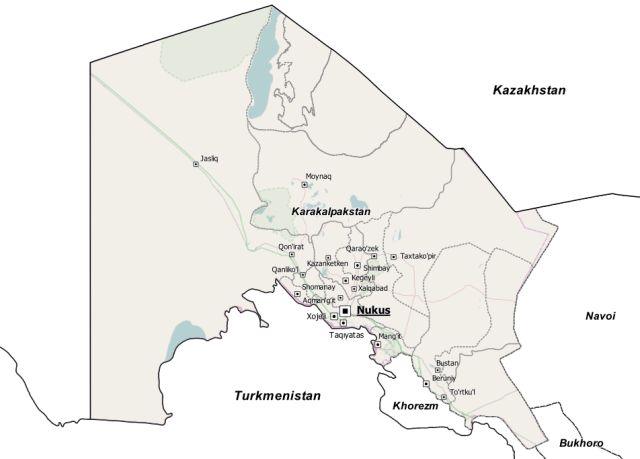Mass riots and protests in the Uzbek autonomous Republic of Karakalpakstan

Author: Giuliano Bifolchi
Protests in the autonomous Republic of Karakalpakstan against proposed amendments to the Constitution of Uzbekistan raised the question of Karakalpak’s complete independence from the Uzbek central government.
On July 1st, 2022, in Nukus, the capital of Uzbekistan’s autonomous republic of Karakalpakstan, thousands of people took to the streets to protest proposed changes to the country’s constitution. According to Telegram channels, people opposed the proposed changes to the Constitution of Uzbekistan, from which, in their opinion, they want to exclude the right of autonomy to secede from the country. Some local sources reported demonstrations also in the cities of Chimboy and Moʻynoq
According to State official sources, the demonstrations resulted from a misinterpretation of the constitutional reforms promoted by the Uzbek government. Therefore, local people gathered and started unscheduled marches around the city of Nukus. Local authorities deployed police and security forces to prevent public order violations and citizens from committing various offences in the area of the protests where they organised illegal demonstrations.
Murat Kamalov, chairman of the parliament of Karakalpakstan, came to meet with the demonstrators. He spoke alongside activist Dauletmurat Tazhimuratov. According to sources, Murat Kamalov told Dauletmurat Tazhimuratov in front of the audience that the authorities had agreed to hold a peaceful rally in Nukus on July 5th, 2022.
On the same day, on the occasion of a ceremony dedicated to Youth Day in the New Uzbekistan park in Tashkent, Uzbek President Shakvat Mriziyoyev stressed the vital link between Uzbekistan and Karakalpakstan, stating that:
“We, two peoples, have become one, we are blood relatives. Two United Nations resolutions on the problem of the Aral Sea have been adopted. Previously, the regions did not know the streets of Karakalpakstan or Nukus, but now we work as one nation, the youth of Karakalpakstan achieve great results. We adopted a strategy for the development of Karakalpakstan, allocated separate funds for the development of each village.”
Geopolitical scenario
Karakalpakstan occupies 40% of the territory of Uzbekistan, and about two million people live here. According to the country’s current constitution, the republic has the right to withdraw from its composition based on a general referendum (Article 74). The draft amendments to the Basic Law of Uzbekistan, submitted to a referendum, do not contain this provision. In addition, it is proposed to change some other articles relating to the status of Karakalpakstan.
According to the latest census, the population is estimated at 1,948,488 (2022), with 51% living in rural areas. Among the main ethnic groups, it is possible to mention Uzbeks (32.8%), Karakalpaks (32.2%), Kazakhs (28.6%), Turkmens (3.3%), Tatars (1.2%) and Russians (1.1%).
The Republic of Karakalpakstan has discrete natural resources, especially of the mining type: copper and silver, but above all, gold and uranium, mainly located in the desert area of Kizilkum, which also extends into neighbouring Kazakhstan and Turkmenistan. Agriculture is one of the main economic drivers in Karakalpakstan’s economy (production of wheat and raw rice, cotton growing, animal husbandry and sericulture). In 2016 the Ustyurt Gas Chemical Complex (GCC), one of the world’s most prominent projects in the oil and gas sector, began to operate.
From an economic point of view, the main Karakalpakstan challenge is the absence or limited presence of infrastructures. In the latest years, the government of Uzbekistan has attempted to stimulate the Karakalpalk economy by attracting foreign direct investments (FDIs) to support socio-economic development.
Risk assessment
In 2014 started first talks about the complete independence of the Republic of Karakalpakstan from Uzbekistan. Then Aman Sagidullayev and other people created the Alga Karakalpakstan movement, which promoted the organisation of a referendum on the independence of Karakalpakstan. The former Uzbek President Islam Karimov announced a hung for dissidents who advocated the complete independence of the Karakalpak Republic. The leaders of the Alga Karakalpakstan movement even asked for protection from the Kyrgyz authorities, fearing abduction by the Uzbek special services.
New trends and sentiments about independence from Uzbekistan reappeared in 2021. Then protests began in the regional centre of Khodjeili, which escalated into clashes with employees of the Ministry of Internal Affairs and the National Guard. One of the reasons for the local disappointment was the decision of the Uzbek leadership on the urgent transition of the Karakalpak writing to the Latin alphabet without asking the opinion of the citizens of Karakalpakstan.
Although often Karakalpalk citizens expressed their desire for complete independence, the hypothesis of secession might be regarded as doubtful for practical reasons. The Republic of Karakalpakstan has little strength to remain independent from an economic point of view or from a political-institutional level. The extreme fragility of the socio-economic context makes it equally difficult for local groups to emerge sufficiently organised to carry out a project of this type.
The independence of Karakalpakstan could become a more realistic scenario if external and neighbouring geopolitical actors support its path, clearly aiming to exert a direct influence on the region’s future. In this sense, the most important candidate might be Kazakhstan, supported by Ankara’s Pan-Turkism strategy.
Considering protests at the beginning of the year in Kazakhstan followed by the Collective Security Treaty Organisations’ military intervention (Geopolitical consequences of the political crisis in Kazakhstan) and recent demonstrations with consequent counter-terrorism operations in the Gorno-Badakhshan Autonomous Region (GBAO) of Tajikistan (Political tensions and security threats in Tajikistan), it is possible to state that ethnic minorities, relations between central governments and local autonomous regions and economic disparity might become severe issues for Central Asian stability.
Declaring the protests as illegal and announcing the military intervention against ‘criminal groups’ or ‘terrorist organisations’ seem to be the primary strategy that Central Asian governments have used to restore their control and contrast any form of demonstration. The possible excessive use of military force and the general lack of understanding of local needs might create more disappointment in autonomous regions and border areas in Central Asia, which jihadist organisations or external forces might use to gain popularity.
